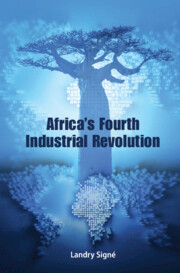Book contents
- Africa’s Fourth Industrial Revolution
- Africa’s Fourth Industrial Revolution
- Copyright page
- Contents
- Figures
- Tables
- Foreword
- Preface
- Acknowledgments
- 1 Introduction
- 2 What Is the Fourth Industrial Revolution?
- 3 What Does the Fourth Industrial Revolution Mean for Africa?
- 4 Drivers of and Challenges to the Fourth Industrial Revolution in Africa
- 5 Capitalizing on the 4IR in Africa in the Primary and Secondary Sectors
- 6 Capitalizing on the 4IR in Africa in the Tertiary Sector
- 7 Leaders in the Fourth Industrial Revolution on the African Continent
- 8 Emerging Leaders in the Fourth Industrial Revolution on the African Continent
- 9 The Imperative of Cybersecurity during the Fourth Industrial Revolution
- 10 The Importance of Health Care and Technological Innovations during the Fourth Industrial Revolution
- 11 Conclusion
- References
- Index
7 - Leaders in the Fourth Industrial Revolution on the African Continent
Published online by Cambridge University Press: 08 June 2023
- Africa’s Fourth Industrial Revolution
- Africa’s Fourth Industrial Revolution
- Copyright page
- Contents
- Figures
- Tables
- Foreword
- Preface
- Acknowledgments
- 1 Introduction
- 2 What Is the Fourth Industrial Revolution?
- 3 What Does the Fourth Industrial Revolution Mean for Africa?
- 4 Drivers of and Challenges to the Fourth Industrial Revolution in Africa
- 5 Capitalizing on the 4IR in Africa in the Primary and Secondary Sectors
- 6 Capitalizing on the 4IR in Africa in the Tertiary Sector
- 7 Leaders in the Fourth Industrial Revolution on the African Continent
- 8 Emerging Leaders in the Fourth Industrial Revolution on the African Continent
- 9 The Imperative of Cybersecurity during the Fourth Industrial Revolution
- 10 The Importance of Health Care and Technological Innovations during the Fourth Industrial Revolution
- 11 Conclusion
- References
- Index
Summary
This chapter highlights South Africa, Tunisia, Mauritius, Morocco, and Kenya as the 4IR leaders in Africa. Each country is compared with the use of the GII and GCI scoring to explore their strengths and weaknesses in the 4IR. The GII is a measure of the components of innovation, while the GCI measures twelve specific components that determine a country’s long-term competitiveness. The two have similar overlaps, but the GII is the primary index of analysis with the GCI as a supplementary unit of information. Following the overall comparison of the five countries comes country-specific analyses that include noteworthy innovations and strengths and challenges. Each country analysis helps in looking at the overall digital maturity of the African continent. It also gives more insightful glance at specific sector reforms and policies.
Keywords
- Type
- Chapter
- Information
- Africa's Fourth Industrial Revolution , pp. 87 - 114Publisher: Cambridge University PressPrint publication year: 2023

